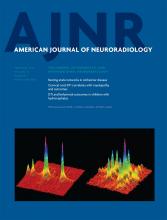I read with great interest the review by Vedolin et al1 and much appreciated their effort to provide neuroradiologists with some help in the diagnosis of the child presenting with ataxia. However, taking into account the practical approach the authors pursued, I would like to draw attention to the information they provided about the most common cause of inherited ataxia, namely Friedreich ataxia (FRDA).
They mentioned FRDA in the group of the most common causes of cerebellar ataxia in childhood showing a degenerative pattern on MR imaging that comprises cerebellar atrophy and signal changes in the cerebellum, brain stem, or both on T1- and T2-weighted images.1 However, the few reports mentioning cerebellar atrophy in FRDA were invariably based on subjective visual assessment of the cerebellar size or were focused on patients with late-onset FRDA, while morphometric assessment failed to show decreased cerebellar volume in patients with FRDA with typical disease onset before 25 years of age compared with age-matched controls.2 Lack of cortical cerebellar atrophy in FRDA was confirmed in a voxel-based morphometry study that, however, demonstrated volume loss of the deep peridentate WM.3 Preservation of the cortex is in line with the pathologic descriptions of FRDA emphasizing that cerebellar damage involves the dentate nuclei and deep cerebellar WM.4 A nonspecific finding emerging in FRDA is atrophy and microstrutural damage of the superior cerebellar peduncles that are correlated with disease duration and severity of the neurologic deficit.2,3 Because the superior cerebellar peduncle contains most of the efferent fibers of the dentate nucleus, which is a site of primary neurodegeneration in FRDA,4 the superior cerebellar peduncle alteration appears a promising biomarker for this disease but is not visually apparent and requires morphometry or computation of DTI measurements to be detected. Also, the increased magnetic susceptibility effects due to iron deposition observed in the cerebellar dentate nuclei of patients with FRDA require specific T2*acquisitions and postprocessing.5 In conclusion, visual assessment of routine MR imaging in FRDA reveals a normal cerebellum for its size and signal.6
It is anticipated that integration of the above information might enhance the practical value of the review. In fact, evidence of a visually normal cerebellum in a patient presenting with ataxia in childhood or adolescence helps support the diagnosis of FRDA and substantially decreases the possibility of other less common recessively inherited ataxias7 and infantile-onset spinocerebellar ataxias, in which diffuse cerebellar atrophy can be present.
References
- © 2013 by American Journal of Neuroradiology












